How many people have heard of Luang Prabang?
Our plan was to find a quiet getaway location to spend the Christmas time, a peak travel time for tourists. We didn’t want to be in big city, and our extended visa was up in Thailand so we decided to fly to… Luang Prabang — a city, I knew absolutely nothing about, in a country I knew next to nothing, Laos.
If you looked at a map you can see it’s nestled snugly in the green mountains of northern Laos, not really close to anything except that it’s positioned on a winding bend of the wide Mekong River. Luang Prabang is a small city (55,000 people), and it’s a little surprising that it has an international airport. It does have some interesting history — important in World War II, and during the Laotian Civil War it was the royal capital. On the surface, all that seemed far in the past, strolling down the quiet streets we saw many hammer and sickle flags flying boldly and proudly.
Laos has about half the area of Thailand, and a tenth of the population. The 7 million people in Laos, compare to about half of the metro area population of Bangkok. But in Laos, only 53% identify as ethnically Lao — and that’s a hint that to the history…
The English word “Laos” was coined by the French, who united the three Lao kingdoms in French Indochina in 1893 and named the country as the plural of the dominant and most common ethnic group, which are the Lao people.
If you are in Luang Prabang it is worth visiting the Traditional Arts & Ethnology Centre which has some explanation of the different ethnicities showcasing the variety of clothing and accessories used to symbolize their lineage and cultural traditions.
 Panorama of Luang Prabang, looking west
Panorama of Luang Prabang, looking west
Hmong New Year
One day in town we met an Australian shop owner in town who suggested we check out the Hmong New Year celebrations which happened to be occurring during our stay. Finding the festival was a challenge because nobody could explain exactly where it was, they just said go behind the airport and follow where everyone is headed. So past a long dusty road past the airport we followed the pickup trucks, tuk tuks and motorbikes to a wooded area which you might call a forest except it was packed with thousands of people, hundreds of food stalls and miscellaneous vendors, smoke filled the air from a range of grilled foods, and loud music flooded the whole area.
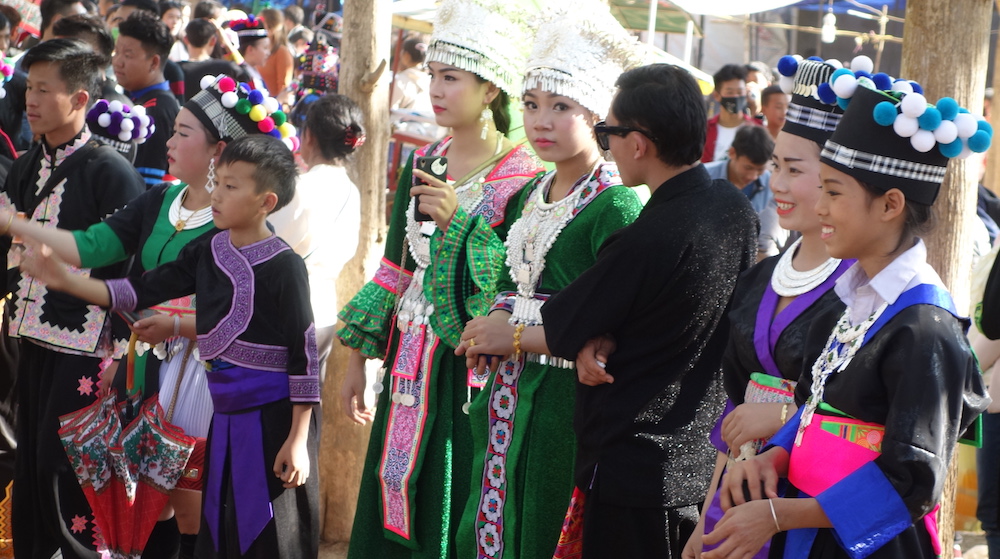 Hmong New Year crowd
Hmong New Year crowd
It was overwhelming at first, taking in the sight of all of these people — we were basically crashing their party. The New Year festival has many important aspects in the Hmong tradition, but the most visible is that it’s a time when people spend some of their saved up money to buy the nicest clothes for their children — a fusion of traditional and contemporary styles. A time to take pictures and show pride in their Hmong heritage. We saw several stalls devoted to taking family pictures with traditional clothes in front of mockups of mountain scenery.
The older children who are ready for the trials of courtship, participate in the “pov pob”, a game involving a ball being tossed between lines of participants with several rules involving the singing of love songs.
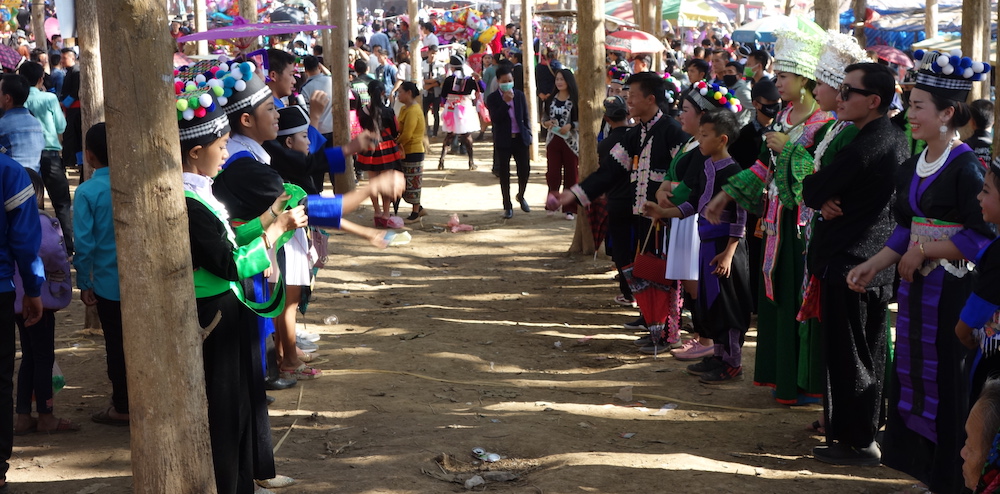 pov pob players
pov pob players
Monks
The town of Luang Prabang is dense with historical temples preserved in large part because of its vibrant monastic community. I’ve read that nearly a third of male Laotian children spend some time as novice monks, mainly as the best available option to get an education, especially for rural children. Many boys start as young as 8, or in some cases even younger. We saw these novice monks everywhere in town — strolling the streets, running errands or doing chores within their assigned temple grounds. Some were eager to chat in English, and spoke quite well.
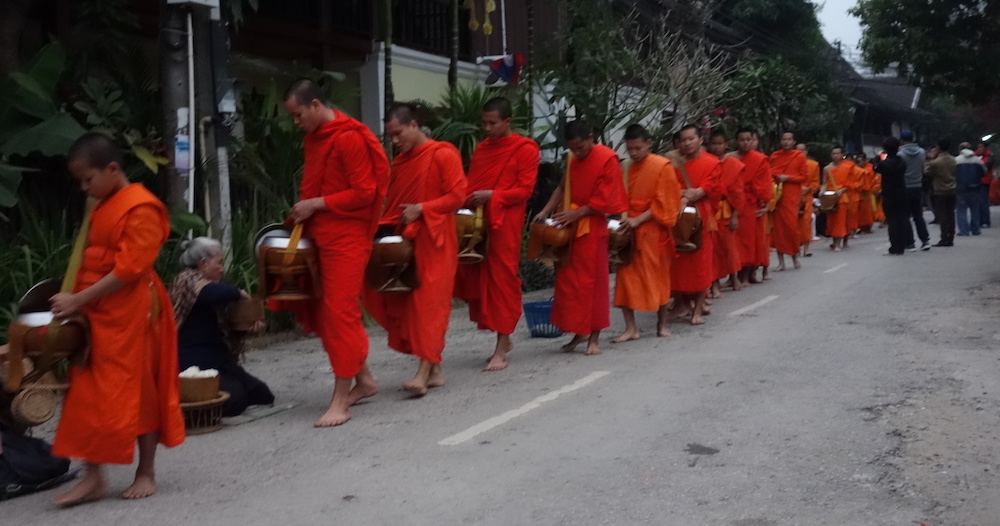 Morning alms ritual
Morning alms ritual
The ritual of the morning offering is carried out in many places across Asia with dense traditional Buddhist populations, and in Luang Prabang it is a spectacle that attracts many people. Monks rise early before dawn and take to the streets to silently and humbly receive offerings of food. In Laos these offerings are mainly chunks of sticky rice which are carefully tossed into the monk’s alms bowls by low-seated almgivers. I saw busloads of drowsy tourists stumbling down to the intersections led by smiling guides snapping pictures of these serious-looking young boys, some sitting at the low plastic seats to participate in the ritual.
Crafts village
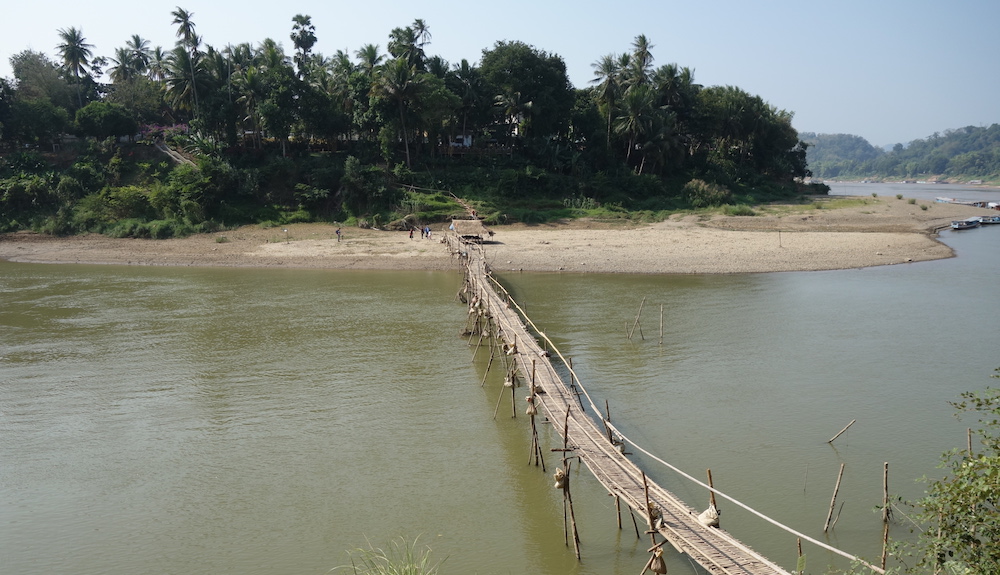 Bamboo bridge over Nam Khan river
Bamboo bridge over Nam Khan river
The center of Luang Prabang is actually a peninsula with the Mekong on one side and a smaller river, Nam Khan, wrapping around the other side. Each year the communities build a bamboo bridge to cross the river, connecting the town to the small villages on the other side. During the rainy season, the Mekong rises and overtakes the bridge to wash it away. The small villages on the other side are known for their paper making and silk weaving crafts. Along the simple dirt road we could see decorative paper in moulds drying in the hot sun. There were also small shops with weavers at looms, and selling truly beautiful items.
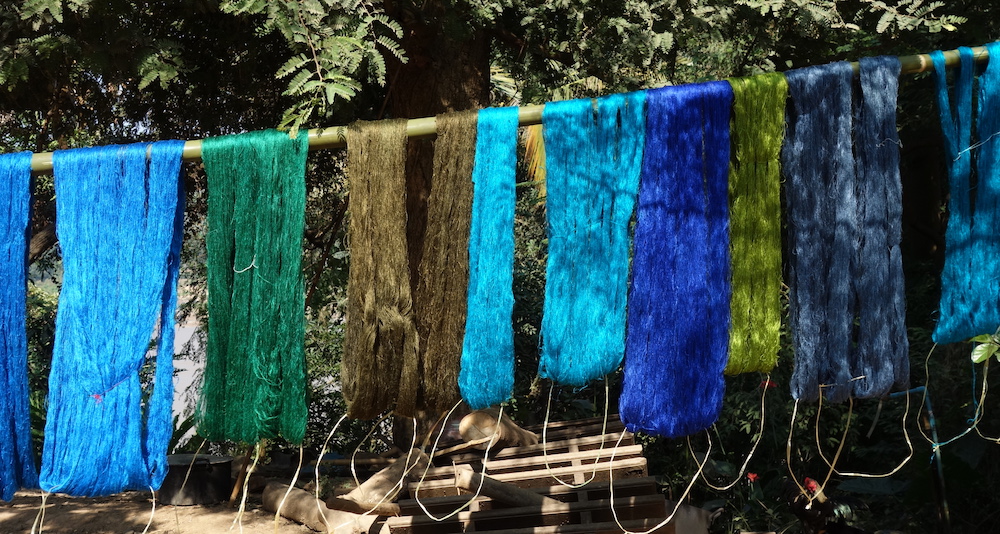 Silk thread, spun and dyed
Silk thread, spun and dyed
It was impressive to see and made me rethink some preconceived notions. When walking into shops in the U.S. lined with silk scarves with a small tag saying made in Laos, I had the vision of a worst case scenario, all these scarves being made in some poorly ventilated sweatshop basement, child labor exploited by oppressive heartless bosses. The picture that replaced that vision was not glamourous nor at all easy, but it was not (apparently) exploitative.
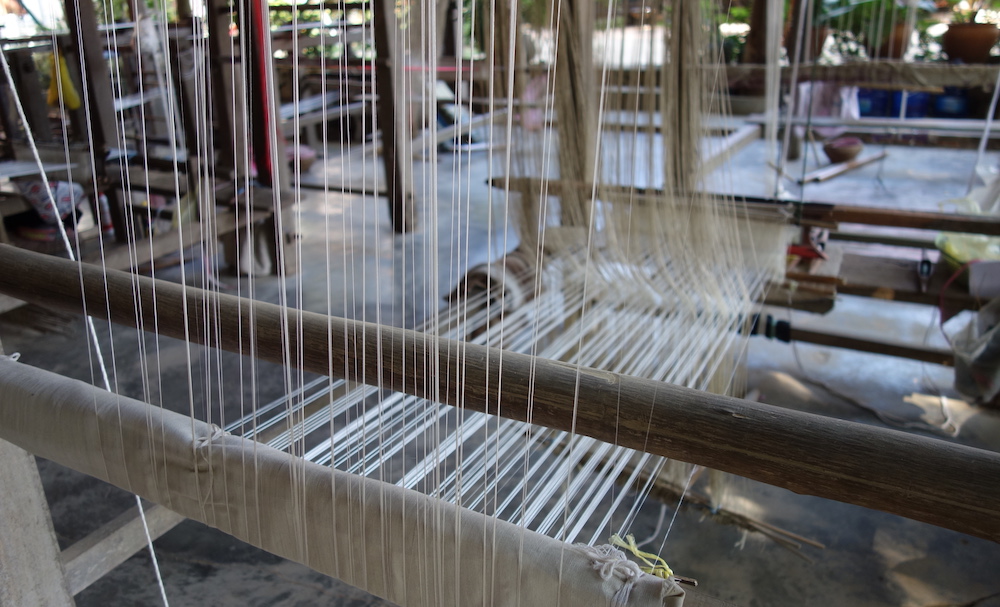 Looms for weaving silk and cotton
Looms for weaving silk and cotton
Money parade
We woke up a little late one morning and heard drumming and music from the street, so we strolled down from the upstairs room of our bed and breakfast to find a parade of thousands of people filing down the main street. They were of all ages and many were carrying … of specially fabricated money trees, that is a metal armature intricately adorned with bills (mostly bills of small value). These money trees were taken to be donated to Wat Xiengthong, one of the main temples of Luang Prabang. The money tree ritual is just one of the ways Buddhists “make merit” – to put it quite simply, merit is accumulated by doing good deeds which has the result of creating a protective and benefical force in the journey to enlightenment. Merit is related to karma but definitely not the same thing. After this experience I started to see money trees on display or tucked away inside other temples in Laos and Thailand.
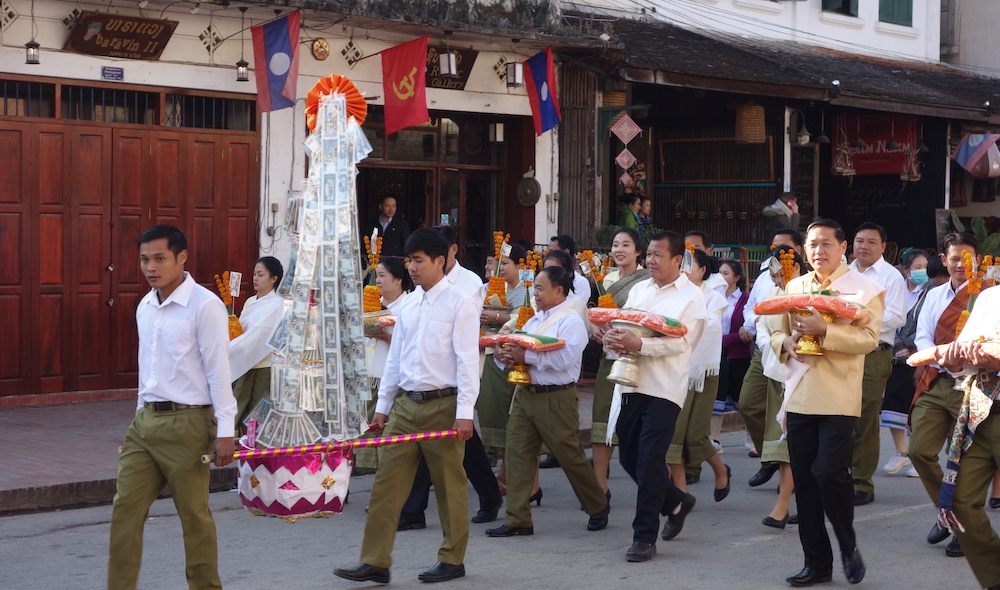 Money tree parade
Money tree parade
Kuang Si Waterfalls
Near the end of our stay we rode the motorbike south, made a short stop at a water buffalo farm for some buffalo milk ice cream, and then kept on to our destination: the famous Kuang Si Falls. Because the water pools over limestone deposits it gives the extensive run of falls a glowing and fantastical feeling. The afternoon sunlight beamed through the clear water bring out bright blues and greens. It was worth the ride. Along the hike up to the falls there was also a small set of exhibits of live Asian black bears. They looked playful but shy in their protected areas.
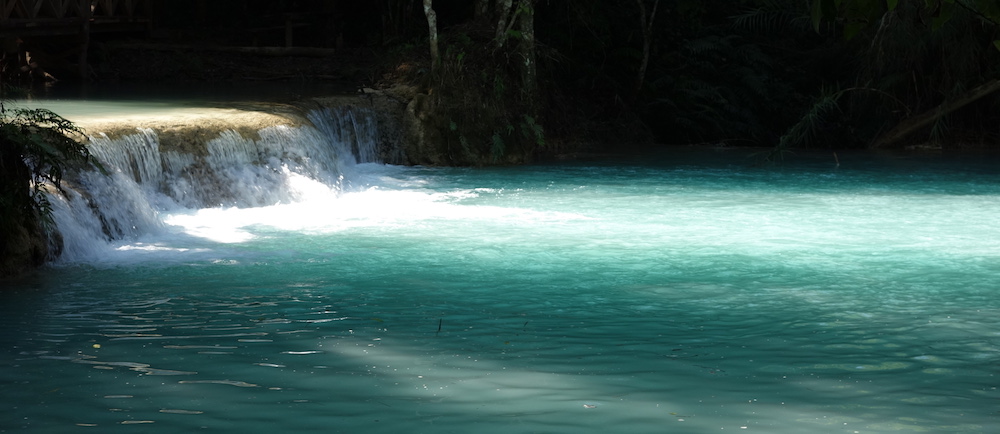 One of the pools of Kuang Si
One of the pools of Kuang Si
One random encounter then led us to another. Based on a tip from a couple Japanese ramen chefs in town, we stopped for dinner at Secret Pizza our way back from the falls. This place is tricky to find and only open 2-3 days a week, but otherwise it’s hardly a secret. It’s a big place and was packed with customers, some Chinese tourists flooded in by the busload. The pizza chef (an Italian expat) built his own brick oven and imports some authentic ingredients with mouthwatering results.
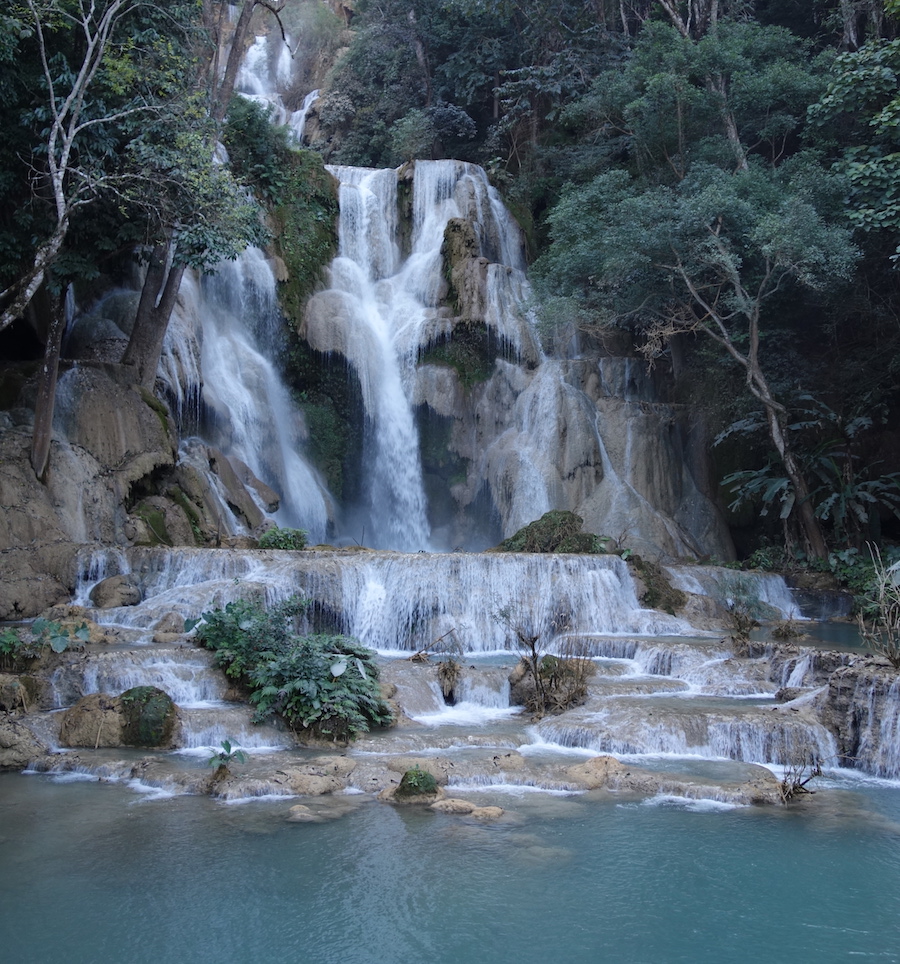 Main Kuang Si Falls
Main Kuang Si Falls
Bus to Old Sukhothai
We wanted to explore a little more of northern Thailand before leaving for Laos. So we decided to take a bus down south to Sukhothai. We arrived at the Chiang Mai bus station with no advance tickets and found out we would have to wait about 3 hours for the next departing bus. Eventually we boarded the bus scheduled to arrive in 5 hours, which turned into 7.5 hours. This was a bus with no bathroom, though we did manage to make stops every 1-2 hours. Asa did surprisingly well.
Then we walked a mile down the road to our guesthouse, checked in, ate dinner, slept well despite the swarming mosquitoes outside our room and a few inside — next morning we hopped on a motorbike and set our sights on Old Sukhothai.
Sukhothai Kingdom
Like Chiang Mai, Sukhothai has a lot of history, only the remains of that history are a lot more visible than in Chiang Mai. The remains are everywhere — an extensive somewhat interconnected complex of temples, nearly 200 ruins total covering about 70 square kilometers mostly built in the 13th century. Most of the important ruins are enclosed within the massive, rectangular triple city walls, though many other temples were built in the surrounding area. The great historical temples we saw in Java (Borobudur and Prambanan) were mostly built with stone, whereas the Sukhothai temples were mostly built with brick and stucco.
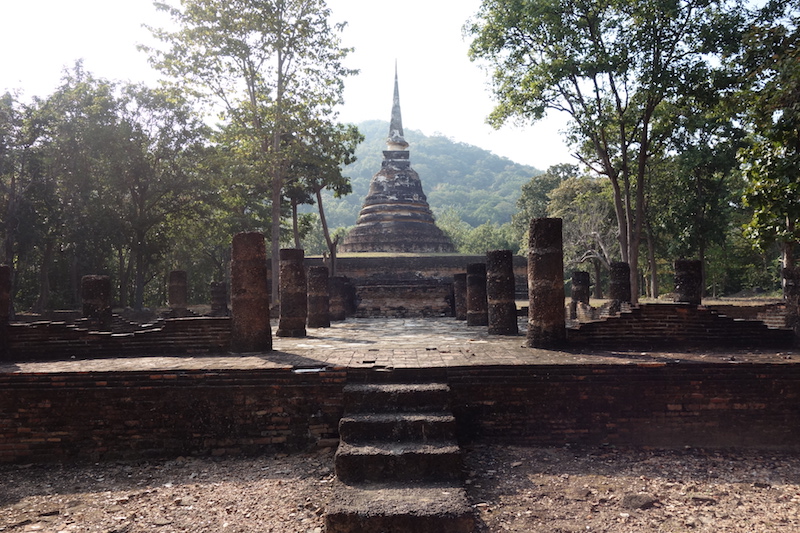 Stupa outside the city walls
Stupa outside the city walls
This from Wikipedia…
Traditional Thai historians considered the founding of the Sukhothai Kingdom as the beginning of the Thai nation because little was known about the kingdoms prior to Sukhothai. Modern historical studies demonstrate that Thai history began before Sukhothai. Yet the foundation of Sukhothai is still a celebrated event.
The old city is now called Sukhothai Historical Park, and in 1991 it was designated a UNESCO World Heritage site, and it is easy to see why. Sukhothai is roughly translated from Sanskrit as “dawn of happiness”. The grounds are fairly lush, well-maintained, easing one into a state of serenity. A serenity that betrays the blood that must have been spilled over the ups and downs of old regional wars, Thai, Burmese, Khmer and others. By the late 14th century the Sukhothai Kingdom was losing influence and was eventually subsumed by the Ayutthaya Kingdom that dominated the region for many centuries.
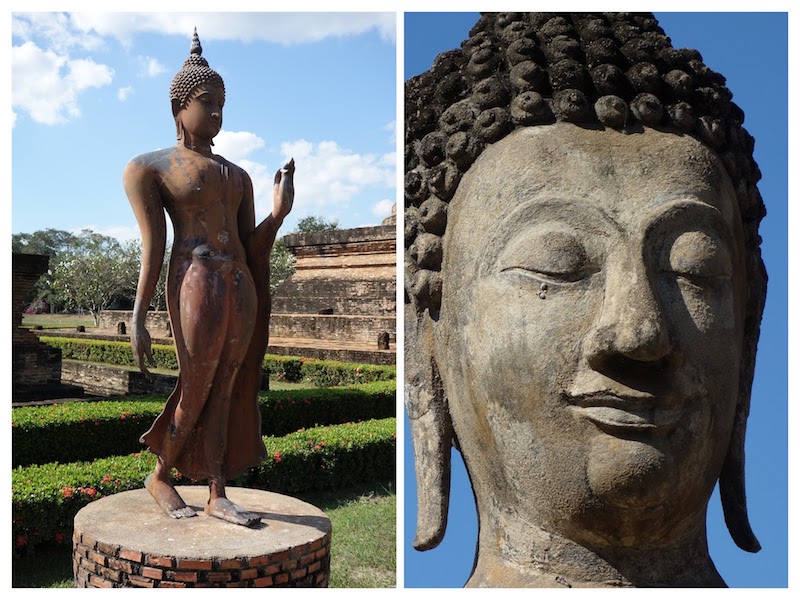 Statues. Left shows Sukhothai style of walking posture, imparting fearlessness
Statues. Left shows Sukhothai style of walking posture, imparting fearlessness
Much work has been done to restore ruins here and there, though really everything looks on the edge of collapse. The first day we explored on motorbike the sites outside the perimeter of the walls. The second day we rented bicycles and roamed around within the walls of the old city. It took a little while to find a bike with a real child seat for Asa – and that is only because most of the bikes we saw were secondhand from Japan. There are many tourists roaming around but, because it is quite large, we never felt like we were getting in the way of someone’s Instagram selfie.
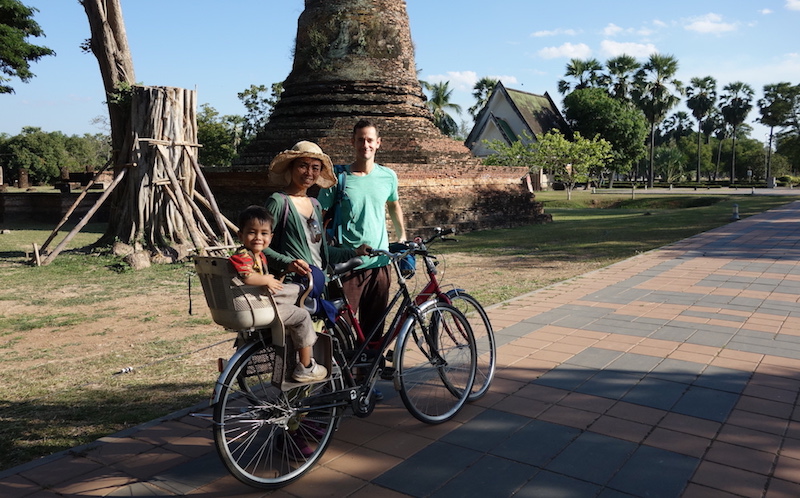 Bicycling in Old Sukhothai
Bicycling in Old Sukhothai
There was no obviously central or single most significant temple in the complex — though there were clearly some major sites. Notable highlights…
Wat Mahathat
The largest and most complicated temple site, with a labyrinth of remaining structures — columns, statues, stupas. The structures felt quite dense and somehow didn’t quite make sense, not following any overarching symmetry or discernible design. Like the whole complex, it must have been built incrementally over many decades.
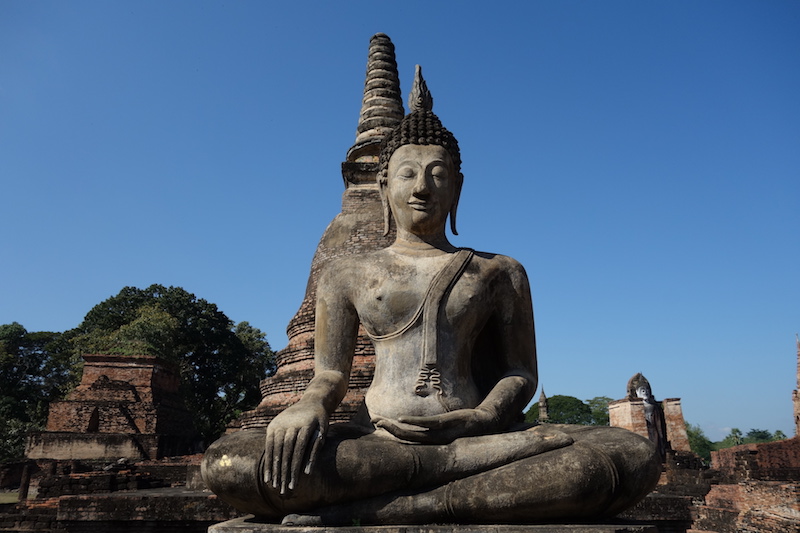 Wat Mahathat
Wat Mahathat
Wat Si Sawai
Possibly the oldest temple in the area, with a design that is clearly different from the others — it was originally built as a Hindu shrine to Vishnu, and later adapted / repurposed for the needs of the Buddhists leaders who took over.
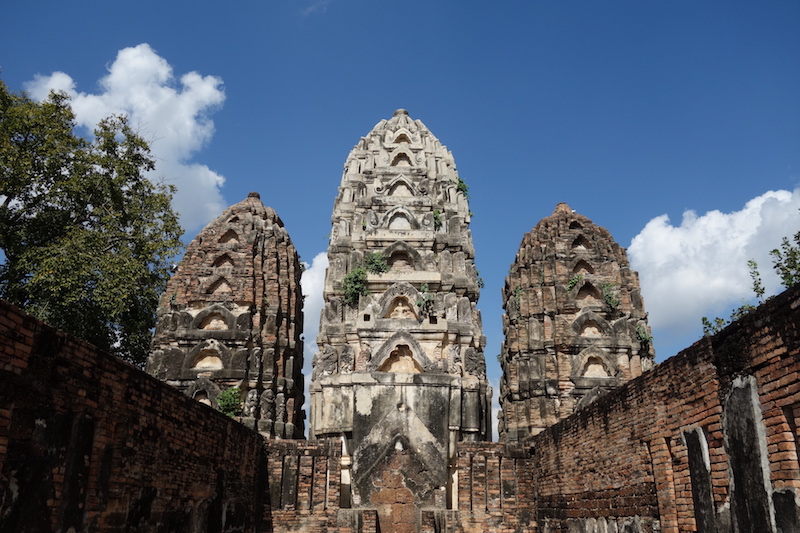 Wat Si Sawai
Wat Si Sawai
Wat Sa Si
Really the most picturesque temple as it’s enclosed in its own moat and connected with small bridges — one to the main grounds, and the other to a small island with a shrine. Unfortunately the moat was under renovation with construction vehicles tearing up the place.
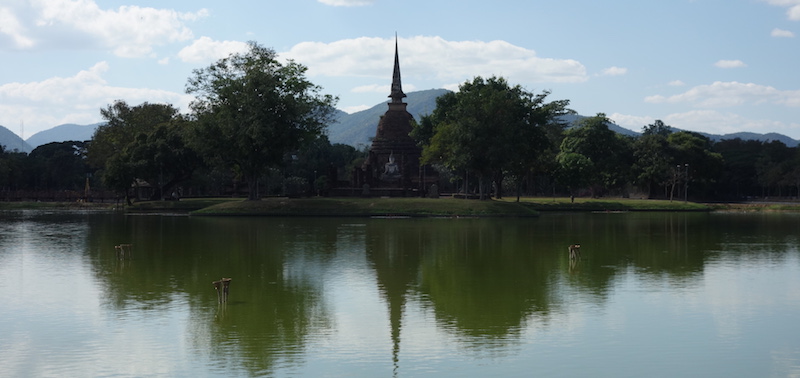
Saritphong Dam
Lies outside the city, and was constructed a large earthen dam as a reservoir to channel water into the canals and various moats of the city. The dam was restored at some point and gave a peaceful mirror image of the green mountains and little else – probably much the same 800 years ago.
 Saritphong Dam
Saritphong Dam
Phitsanulok
We didn’t really have time to explore any of New Sukhothai, a small city built down the road from the historical park. But after leaving our guesthouse in Sukhothai we spent one night in the neighboring city, Phitsanulok, which is probably pretty similar in size and feeling to New Sukhothai. The main activity we enjoyed was visiting the nearby temples, one of them had an herbal sauna — small steam rooms infused with the overpowering scent of lemongrass.
Our one night in Phitsanulok happened be Asa’s 4th birthday so he got to choose dinner: pizza, of course. There was a Pizza Hut just a short walk from our guesthouse. We came to Phitsanulok to be close to the airport because we had an early flight, and it didn’t help that we overslept and rushed through breakfast and minutes later onto a little tuk tuk. From Phitsanulok we caught a connecting flight in Bangkok and onto Luang Prabang, Laos.
I am a lover of creatures great and small, and I am generally averse to causing harm to anything. I make special exceptions to mosquitoes and cockroaches. Whereas the cockroach seems inherently skin-crawlingly revolting, the offensiveness of the mosquito is more subtle, its parasitic nature combined with its itchy injection. But both are bothersome for their multiplicity and their elusiveness.
Pruritus
Few things elicit more frustration than being in a darkly lit room with dark colored surfaces (easy hiding places) and being stalked by a mosquito, or who knows maybe two or three. They buzz and hide, appear for a second, SWAT! when you just know you caught it between your palms only to open them and reveal in fact it escaped again. Completely disappeared. You turn on a light, then you turn on all the lights looking high and low, maybe rustle the curtains a bit.
About the time I get 4 consecutive bites I feel like my brain chemistry changes. My primitive brain takes over and I become a panicked primate stalked by lions or hyenas. My mind will not rest until it finds the peace of knowing there will be no more bites, no more itchiness. The repellant wears off too fast. The only way to be sure is to hunt them down with ready hands, eyes picking out dark specks on the walls, the curtains, the furniture; the little hind legs dangling in the air, sensing any change in air pressure, any warmth, the smell of breath and hot blood. And when the dark blood (my blood!) gets smeared on my hands the satisfaction wears off too soon because there are too many out there — just beyond this mosquito net, or window screen, or car door — the larva wriggling by the thousands, billions in stagnant pools of water.
I am actually lucky that my reaction to the bites is not as strong as some people, and I have good will power to resist the urge to scratch and let the itchiness subside. But does the world really need these insect vampires? The fish and frogs that eat the larva surely will find other things to fill their bellies; as will the dragonflies and spiders that gobble up the adult mosquitoes like chicken wings.
And then there’s the diseases. Because I’ve had dengue before, a long time ago, luckily not malaria or worse. But I know the toll. So to my mind they have too many strikes against them.
Enough is enough.
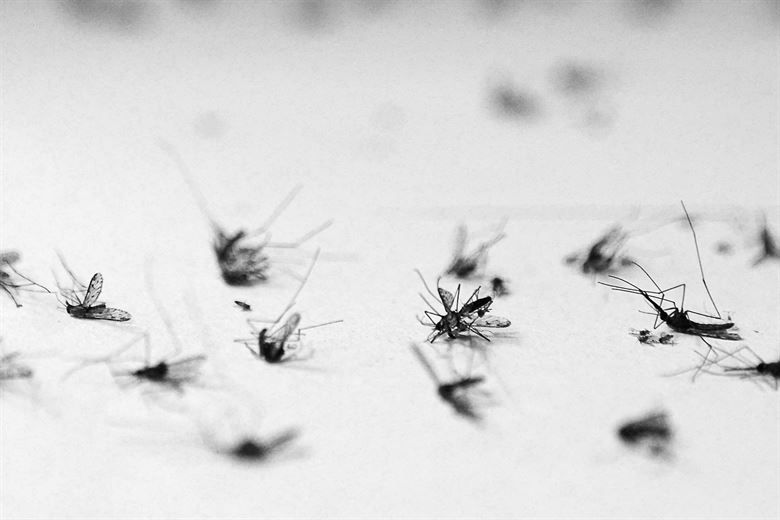 Mosquitoes - image source
Mosquitoes - image source
Chiang Mai — this was the place I was most excited about, because I had heard people talk about it so much. Though really I think I had glossed over the details, so in reality I knew very little about it. Mainly I had heard about it being the coworking capital of Southeast Asia (more on that later).
Chiang Mai means “new city” and is the largest city in northern Thailand. Seemingly like most cities in continental Southeast Asia, it was once the capital of some long-since-past kingdom. In the case of Chiang Mai it was the Lan Na kingdom in the 13th century, which before that was in Chiang Rai. Because of its dynastic history a defensive square moat was constructed each side 1.5 km, and the moat remains in good condition now with bridges all along. Inside the moat is known as the “old city”. The moat creates a confusing flow of traffic — the road on the outside perimeter of the moat runs clockwise and counterclockwise inside the moat. So going from point A to point B often involves a series of U-turns.
Centered around old city is a series of about three rings roads, highways really, intersected by radial highways leading in and out. It felt surprisingly well-designed. The west side of the city is flanked by Doi Suthep, a small mountain with a famous temple Wat Phra That Doi Suthep, that is lit up at night overlooks the city.
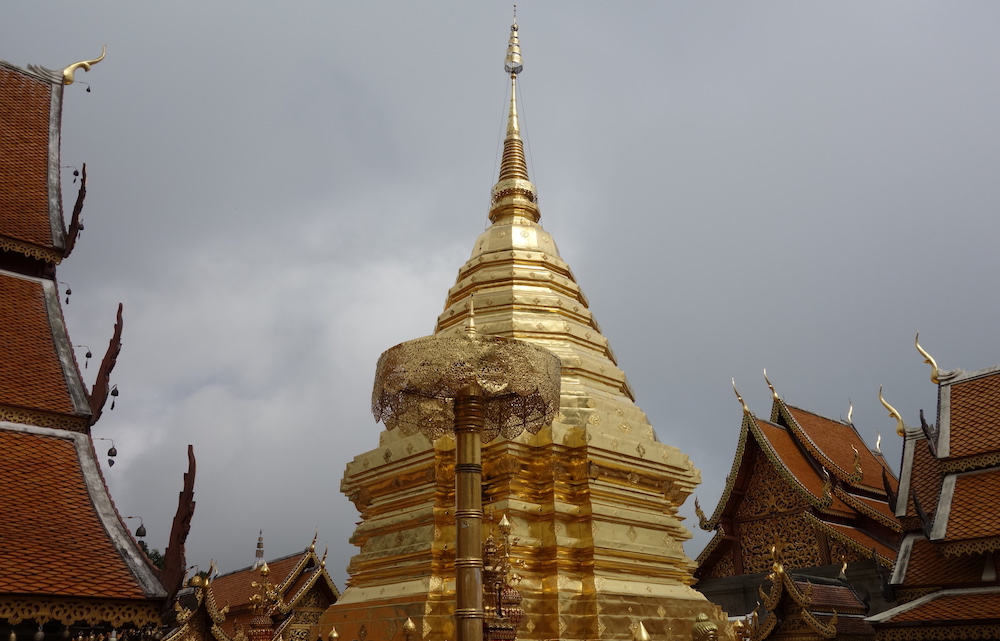 Wat Phra That Doi Suthep
Wat Phra That Doi Suthep
Seraphi
But our introduction to the city was gradual because our first destination was Seraphi (or Serapee), well south of the city. The Uber driver had a hard time finding the place — it was far past the 3rd ring road. But we got there eventually, an old rustic Thai style house. Thai houses are traditionally raised on stilts away from the flooding that comes in the rainy season, and the house is set apart from the kitchen and the bathroom — as was the case in this guesthouse.
Also, every traditional Thai house has a house shrine (or “spirit house)”, which looks like a mini house on a dais, and can be found throughout Thailand, Laos, Cambodia and Burma. Please the spirits of the shrine (with daily offerings and prayer) and you will keep a happy house. The house shrine also should not lie in the shadow of the house. Actually these shrines are not limited to houses, but can be found outside apartment buildings, shopping mails and other businesses.
The staff at our guest house spoke little English and managed using the Google translate app. This was quite contrary to our experience in Phuket where everywhere was filled with tourists and felt tailored for tourists. In Seraphi there were few people who could speak English but there was good food, and interesting places to be found: a honey factory, a fruit-drying factory and a 20-min motorbike drive to the famous Baan Tawai craft village.
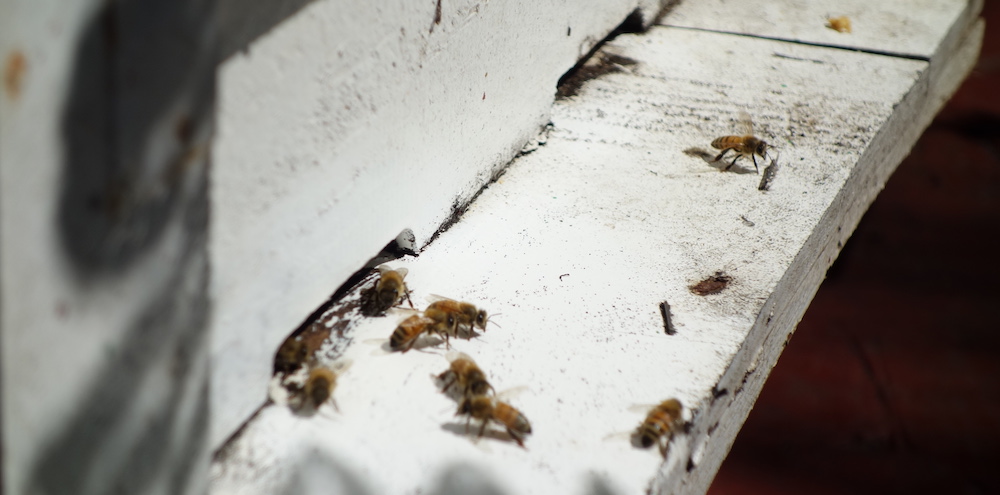 Bees outside the honey factory in Seraphi
Bees outside the honey factory in Seraphi
House Hunting & Checkpoints
After spending a few days of down time Seraphi we began our search for a month-long rental closer to the center, one where I would be able to settle on a coworking spot. This was November, high season for tourism in northern Thailand. This house hunting turned into about three and a half days roaming around some areas northwest of the Old City — mainly near the huge Chiang Mai University; and Nimmanhemmin, the epicenter of expat life in Chiang Mai.
 Doi Suthep mountain from the large reservoir on CMU campus
Doi Suthep mountain from the large reservoir on CMU campus
On our first day house hunting driving through the Old City once inside the moat we came face-to-face with the reality of being outsiders in a place where authorities have unquestioned control, but used arbitrarily. That is to say… corruption. In this case, it was in the form of a “tourist checkpoints” — where the police round up any motorbike riders who don’t look Thai to find some way to get them to pay a fine (improper license, improper motorbike, improper helmet, unpaid road tax — all of this in some gray area of legal offense).
My fine: 500 baht for an international driver’s license without a stamp for driving a motorcycle. My payment would excuse me for up to 3 days, after which point, if caught again, I would pay the same fine. Luckily there was no next time, mainly because once we left Seraphi we gave up the motorbike. The whole experience was disturbing because I felt I had been violated — albeit in a very mild form. I saw many checkpoints over the many weeks we were in Chiang Mai — and we have not seen them anywhere else in Thailand.
After 3 days of hunting we still hadn’t quite decided and we’re able to move in right away so we stayed a few nights at a Japanese run hostel that we very accidentally came upon. This was a super convenient place and Asa discovered many interesting people to play with and chat in Japanese.
Later on we settled on an Airbnb apartment sandwiched between a Japanese nightclub and a late night BBQ buffet restaurant. The apartment itself was a sizable studio, with a semi-functional kitchen and a view of the mountains. The kitchen was a tricky part — since Thai houses don’t often have indoor kitchens, many apartments don’t have any kitchens and people instead prefer to just eat out or buy their meals for take out.
Loi Krathong
The main attraction for November is Loi Krathong — the lantern lighting full moon festival. Historically special time is the last full moon of the Thai year when people make a special floating lantern to make a wish for the coming year. The floating lanterns were usually highly decorated rafts (some small, some large) with a lit candle placed on the river. This seems to have evolved at some point to sky lanterns — cloth boxes with a little fuel cell inside, enough heat to make the lantern rise high into the sky if it doesn’t crash and burn to the ground first.
We went to Narawat Bridge — the epicenter of the sky lantern lighting. Really it was almost entirely filled with eager, half-drunk or full-drunk tourists lighting up lanterns and releasing them skyward with some success and some scary failure.
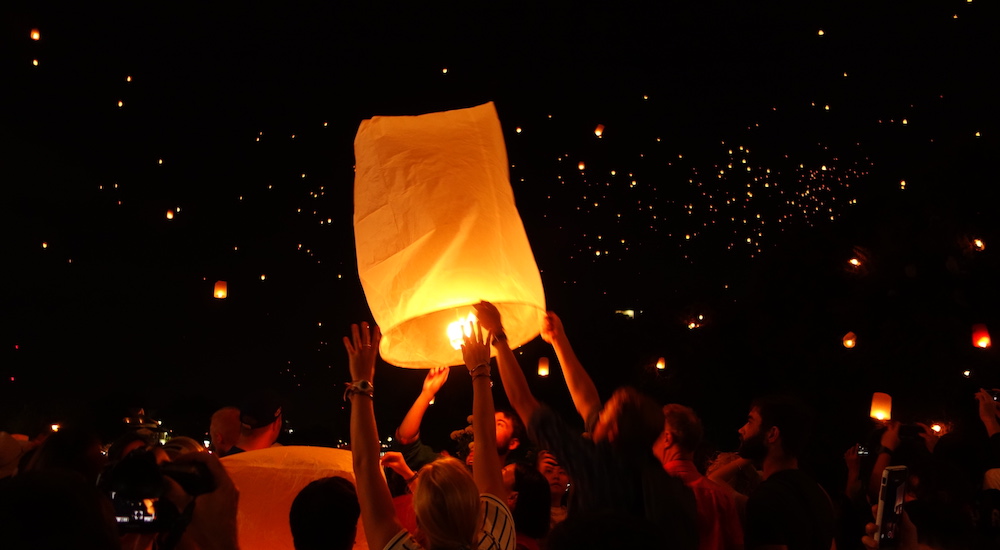 Loi Krathong at Narawat Bridge
Loi Krathong at Narawat Bridge
Still, there was something quite magical about it. So it’s easy to look past the environmental impact and the impact to air traffic — which is why the sky lanterns are altogether banned in Bangkok.
Coworking Capital
My first pick for coworking spot turned out to be full — which I didn’t anticipate. So I trudged down the street to a neighboring spot and settled down for (what ended up being) 5 weeks of work. It was mostly filled with young male Europeans. On hot days it felt like I was in a sweaty gym, every programmer on their own hamster wheel. But I had no working schedule — so I worked most weekends when it was always quiet and took off the occasional weekday so the three of us could explore Chiang Mai.
I looked at about 8 different coworking places all over Chiang Mai, and really the one I found was pretty good (though not nearly as pleasant as the one I was at in Ubud). Before arriving in Chiang Mai I thought it would be either the kind of city that feels like a mini tech hub (with lots of tech startups) or a tech getaway center (catering to traveling tech workers). Neither was true really. There are startups and plenty of traveling techies. But I think the rise of coworking spots in Chiang Mai is because it’s a very expat friendly place outside of the expensive Bangkok rat race.
This really boils down to my own reeducation about what coworking is and is becoming. Coworking is for everyone — occasional travelers and perpetual expats — but really it’s also (forgive the cliche) a lifestyle. As remote work becomes more possible for all professions, not just programmers and developers, coworking companies broaden their appeal by offering subscriptions to a network of offices throughout Asia or the world. Travel and work, travel and work, travel and work — as separated or mixed together as you like. In this respect, Chiang Mai is only unique in that it seems to have started this early — so it’s established, but not quite matured yet. It will be interesting to see how this changes as the startups in the area really do start to take off and who will be the undisputed leader in coworking.